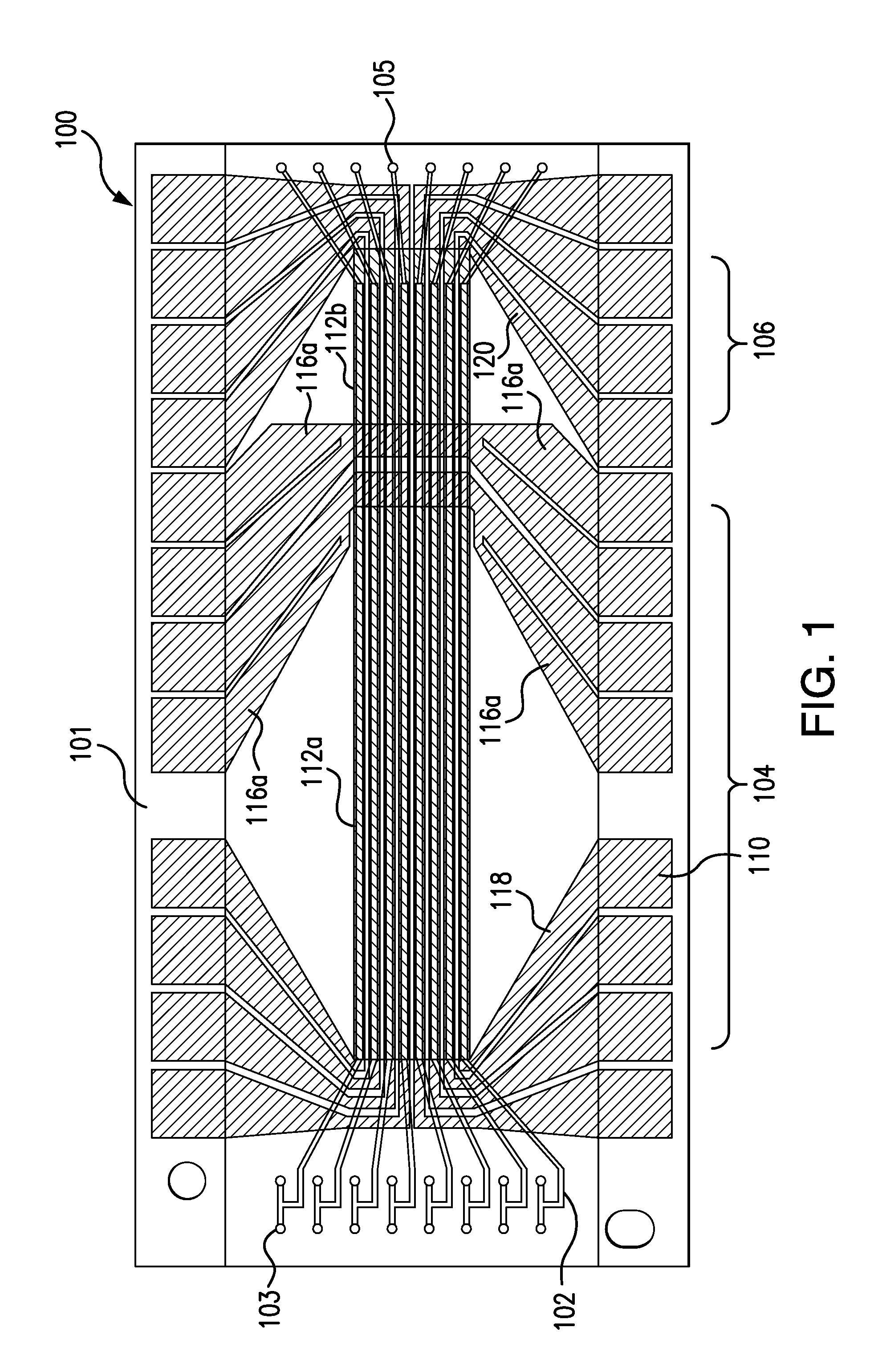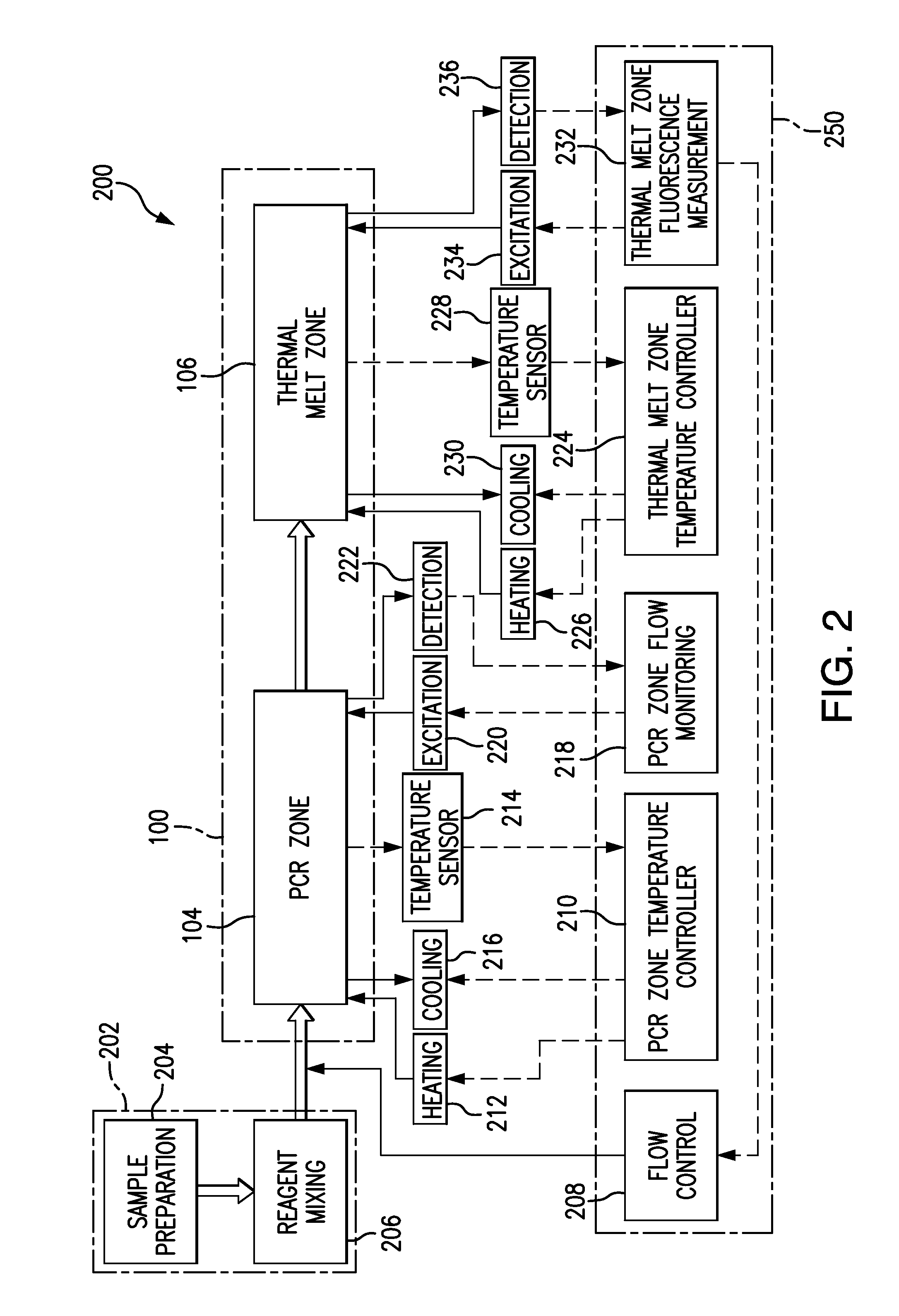[0015]In a further embodiment, the method may include repeating steps a-e for each additional thermal element in the thermal device. In a further aspect, the thermal device may be a microfluidic channel in thermal communication with a plurality of thermal control elements.
[0016]In a further embodiment, the first thermal zone may be thermally isolated from the second thermal zone. The first thermal zone and the second thermal zone may be calibrated in parallel. In another embodiment, the first thermal zone and the second thermal zone may be calibrated in series. In still another embodiment, the compound calibrator may be a mixture of two or more amplicons of a nucleic acid.
[0017]Another aspect of the present invention is a method for calibrating a plurality of thermal control elements in a thermal device. In this aspect, the method may include the steps of (a) providing a compound calibrator in a first thermal zone, wherein the first thermal zone is in thermal contact with a first of the plurality of thermal control elements, (b) utilizing the first thermal control element to perform a thermal variation, generating a first thermal response profile for the compound calibrator, (c) identifying a first feature of the first thermal response profile and generating a first relation between a known temperature of said first feature and a first measurement value of the first thermal control element, (d) identifying a second feature of the first thermal response profile and generating a second relation between a known temperature of the second feature and a second measurement value of the first thermal control element, (e) identifying a third relation between a known ambient temperature and measurement value of the first thermal control element, (f) calculating one or more calibration coefficients for the first thermal control element based on at least the first, second, and third relations, and (g) repeating steps a-f using the compound calibrator in a second thermal zone, wherein the second thermal zone is in thermal contact with a second thermal control element.
[0018]In another embodiment, a method for calibrating a thermal control element is provided which may include the steps of (a) providing a compound calibrator in thermal contact with the thermal control element, (b) utilizing the thermal control element to perform a thermal ramp, (c) generating a melt curve for the compound calibrator, (d) identifying a first feature of the melt curve and generating a first relation between a known temperature of the first feature and a first measurement value of the thermal control element, (e) identifying a second feature of the melt curve and generating a second relation between a known temperature of the second feature and a second measurement value of the thermal control element, and (f) calculating one or more calibration coefficients for the thermal control element based on at least the first and second relations.
[0019]In this embodiment, the method may further comprise identifying a third relation between a known ambient temperature and a third measurement value of the thermal control element, wherein the step of calculating one or more calibration coefficients is further based at least on the third relation.
[0020]In a further embodiment, a method for serially calibrating a plurality of thermal control elements in a microfluidic channel which may include the steps of (a) providing a compound calibrator in thermal contact with a first of the plurality of thermal control elements, (b) utilizing the first thermal control element to perform a thermal ramp, generating a first melt curve for the compound calibrator, (c) identifying a first feature of the first melt curve and generating a first relation between a known temperature of the first feature and a first measurement value of the first thermal control element, (d) identifying a second feature of the first melt curve and generating a second relation between a known temperature of the second feature and a second measurement value of the first thermal control element, (e) calculating one or more calibration coefficients for the first thermal control element based on at least the first and second relations, (f) providing the compound calibrator in thermal contact with a second of said plurality of thermal control elements, (f) utilizing the second thermal control element to perform a thermal ramp, generating a second melt curve for the compound calibrator, (g) identifying a third feature of the second melt curve and generating a third relation between a known temperature of the third feature and a third measurement value of the second thermal control element, (h) identifying a fourth feature of the second melt curve and generating a fourth relation between a known temperature of the second feature and a fourth measurement value of the second thermal control element, and (i) calculating one or more calibration coefficients for the second thermal control element based on at least the third and fourth relations.
 Login to View More
Login to View More 


